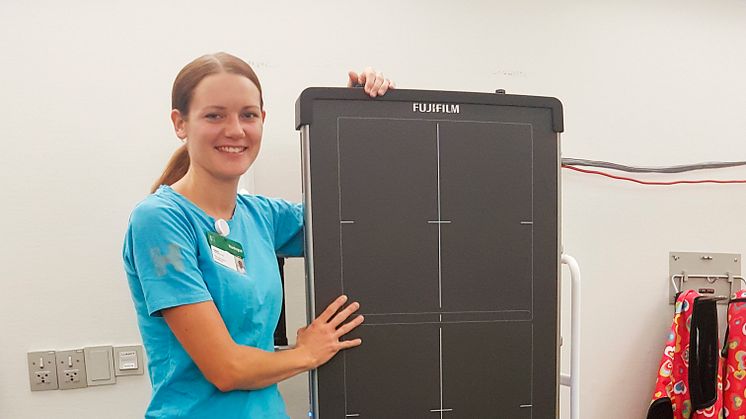
Uutinen -
"We have cut examination time by half”
Since mid-June the Copenhagen University Hospital (Rigshospitalet) has been evaluating Fujifilm’s long panel for scoliosis and hip/knee/ankle examinations and is very satisfied with the result.
“Many of our patients find it difficult to sit or stand; it causes them pain or they need someone to support them, which is further complicated if the examination takes a long time. The long panel is very fast, it takes less than half the time to carry out the examination, sometimes it is even faster. Many patients have said ‘Wow, that was fast!’ They are relieved that they do not need to sit or stand for a long time,” says Pernille Klenz Andersen, radiographer at Rigshospitalet.
With 255 000 examinations per year, the Department of Diagnostic Radiology at Rigshospitalet in Copenhagen is the largest radiology department in Denmark. About 3 000 scoliosis examinations are carried out annually on patients from all over Denmark, as most forms of progressive scoliosis are referred to Rigshospitalet.
When radiographer Pernille Klenz Andersen started at Rigshospitalet eleven years ago she saw that many scoliosis patients suffered from having a long wait to see that the result of the exposure was successful.
“At the ECR held in Vienna ten years ago I went round asking the exhibitors if anyone had developed a direct digital long panel. Everyone said no. Some years passed, and then I was very glad to hear the news that Fujifilm were developing a long detector.”
Since mid-June this year she and her colleagues at Rigshospitalet have carried out 300 scoliosis examinations. Apart from saving time for patients and staff, which will ultimately lead to the hospital being able to take more patients, Pernille says that other major advantages of the long panel are being able to use a lower radiation dose while obtaining at least as good an image quality as before, and ergonomic benefits for her and her colleagues, as they do not need to handle the long cassettes which contained the image plates.
FACTS
FDR DEVO GL
- Long direct digital detector
- Large exposure surface of 43x125 cm
- “Long images” with just one exposure
- Can be used for example for scoliosis and hip/knee/ankle examinations
RIGSHOSPITALET
- The Copenhagen University Hospital, Rigshospitalet, was Denmark’s first real hospital, first opened in 1757 under the name “Royal Fredriks Hospital” offering free care and treatment for poor Copenhageners.
- In 1910 the hospital became state-owned and moved to its present location on Blegdamsvej. The hospital also changed its name to Rigshospitalet, as from then on it was to be accessible to all citizens of the kingdom of Denmark.
- The present buildings were erected in the 1960s and on 1 January 2015 Rigshospitalet merged with Glostrup hospital.
- The Department of Diagnostic Radiology has 270 employees and carries out diagnostics and treatment at a highly specialised level, receiving patients from the entire country as well as the Faroe Islands and Greenland, as well as teaching radiography and medical students.
- The radiology clinic performs conventional x-rays, angiography, CT scans, MRI and ultrasound examinations. The Department uses RIS and PACS.
- The annual budget is about DKK 150 million and the department performs about 255 000 examinations per year, of which about 3 000 scoliosis examinations and 120 hip/knee/ankle examinations.